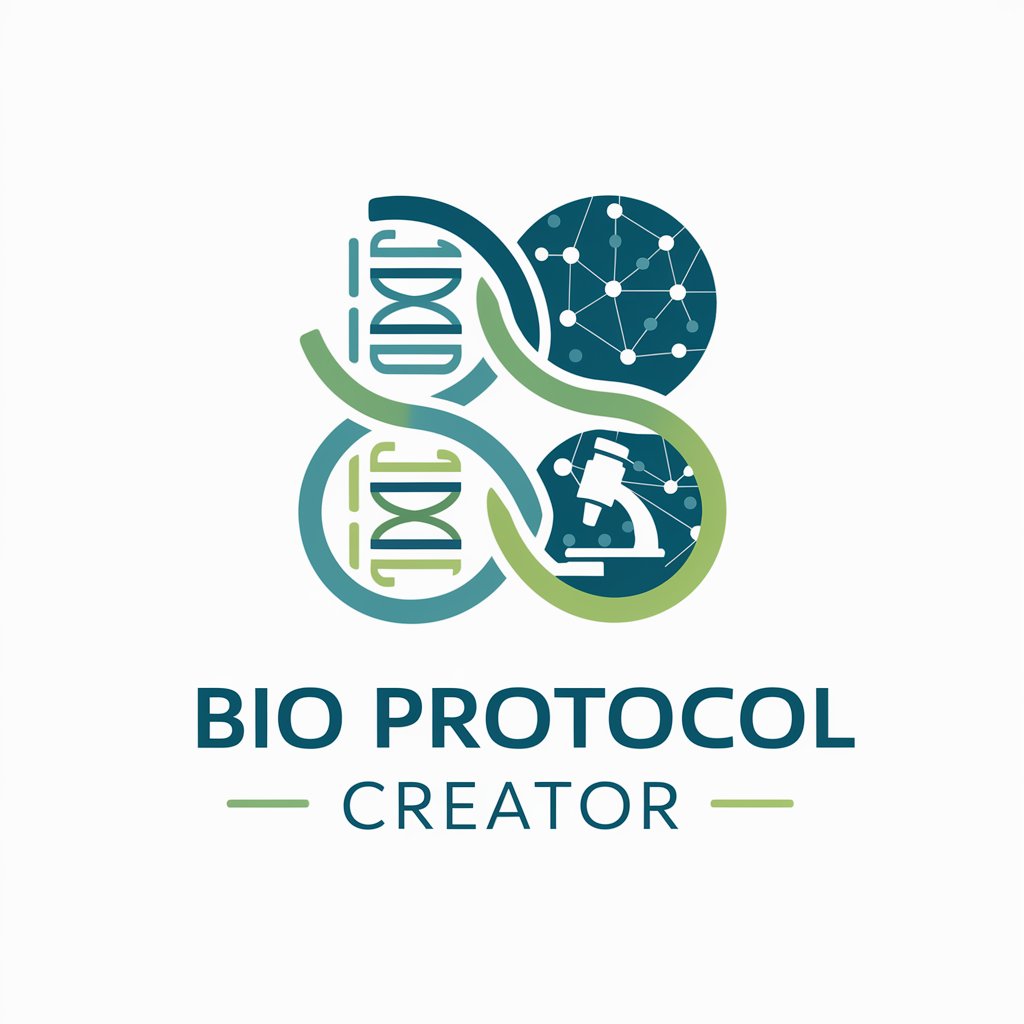Protocol Generator from knock in to WB - Gene Editing Protocol Design

Welcome to Bio Protocol Creator, your advanced research assistant.
Streamline Your Experiments with AI-Powered Protocols
Describe the steps involved in a CRISPR-Cas9 gene editing experiment...
Outline the protocol for detecting protein oligomerization using Western blotting...
Explain how to design and implement a FRET-based experiment for studying protein interactions...
Provide a detailed materials list and procedure for a cell lysis protocol...
Get Embed Code
Introduction to Protocol Generator from Knock-In to WB
Protocol Generator from Knock-In to WB is an advanced tool designed to streamline the process of generating detailed experimental protocols for biological research, specifically focusing on the manipulation of genomic sequences (knock-in techniques) and the subsequent analysis of protein expression (Western Blotting, WB). This tool caters to the needs of molecular biologists, genetic engineers, and biomedical researchers who require precise, efficient, and reproducible methods for gene editing and protein analysis. It integrates knowledge and methodologies from various state-of-the-art techniques, including CRISPR-Cas9 mediated homologous recombination for targeted gene insertion (knock-in) and the detection of protein interactions or expressions through WB. For example, the tool can generate protocols for creating a MYF5 reporter human iPS cell line using CRISPR/Cas9, aimed at studying muscle differentiation, and guide through the subsequent steps for protein expression analysis using WB, illustrating the comprehensive utility of this tool in facilitating cutting-edge research. Powered by ChatGPT-4o。

Main Functions of Protocol Generator from Knock-In to WB
Generation of Knock-In Reporter Lines
Example
CRISPR/Cas9 mediated homologous recombination is employed to insert a 2A-GFP reporter before the stop codon of the MYF5 gene in human iPS cells. This allows for the prospective identification and purification of myogenic progenitors.
Scenario
Researchers can use this function to study early myogenic specification or other cellular differentiation processes by tracking the expression of the reporter gene integrated into a specific genetic locus.
Characterization of Knock-In Effects
Example
Following the generation of knock-in reporter lines, the Protocol Generator guides users through the steps for characterizing the genomic modification. This includes PCR and sequencing validation of reporter clones to confirm in-frame positioning and absence of off-target effects.
Scenario
This is particularly useful for validating the success of the genetic modification and ensuring the reliability of the experimental model before proceeding with further experiments.
Western Blot Analysis
Example
After genetic modification and cellular differentiation, the Protocol Generator provides detailed steps for protein extraction, gel electrophoresis, and immunoblotting to detect the expression of target proteins, such as the ASC oligomerization in macrophages.
Scenario
This function is crucial for researchers aiming to verify the protein-level effects of genetic modifications, such as the expression of a reporter protein or the impact of gene editing on protein interactions and pathways.
Ideal Users of Protocol Generator from Knock-In to WB
Molecular Biologists and Genetic Engineers
Professionals in these fields will benefit from the tool’s capacity to design precise genetic modifications and analyze their effects at the protein level, enabling advanced studies in gene function, regulation, and protein interactions.
Biomedical Researchers
Researchers focusing on disease modeling, regenerative medicine, and therapeutic target discovery will find this tool invaluable for generating and characterizing disease-specific or therapeutic-relevant genetic models in vitro.
Academic Instructors and Students
Educators and learners in genetic engineering and molecular biology disciplines can utilize this tool for educational purposes, enhancing understanding of gene editing technologies and protein analysis techniques through practical application.

Using the Protocol Generator from Knock-in to Western Blotting
1
Visit yeschat.ai for a free trial without login; no ChatGPT Plus is required.
2
Select the experimental technique you're interested in, such as CRISPR-Cas9 for gene editing, FRET for protein interactions, or Western blotting for protein analysis.
3
Input specific parameters for your experiment, including sample type, target proteins or genes, and desired detection methods.
4
Review the automatically generated protocol, which includes detailed steps, required materials, and expected outcomes.
5
Utilize the interactive tools to adjust the protocol parameters based on preliminary results or specific experimental needs.
Try other advanced and practical GPTs
Mr Knock Knock
Dark humor at your command.

Carbon Footprint Calculator
AI-powered Travel Emissions Calculator

Carbon Tracker
Track, Analyze, Reduce: Powered by AI

Tour in Sri Lanka
Your AI-powered guide to Sri Lanka

World Tour Farming Simulator!
Cultivate globally, harvest AI-driven success

Tour Guide
Explore Smarter, Travel Better with AI

Nock it the Pocket
Navigate New Jersey Traffic Laws with AI-powered Precision

Knock-off Danish Toy Brick Set Creator
Build your dream playset with AI

The Best Cook
Culinary expertise, AI-powered.

Cook Vegan Food Right
AI-Powered Vegan Cooking Companion

Cook Chinese Food Right
Master Chinese cuisine with AI

Student Cook Book
AI-powered Cooking Simplified

Frequently Asked Questions About Protocol Generator from Knock-in to Western Blotting
What is the Protocol Generator from Knock-in to Western Blotting?
It's an advanced AI tool designed to generate precise experimental protocols for various genetic and protein analysis techniques, including CRISPR-Cas9 gene editing, FRET, and Western blotting. It allows researchers to input specific experimental conditions to receive customized, step-by-step methodologies.
How can I customize a protocol using this tool?
Users can customize protocols by inputting specific experimental variables such as target genes or proteins, reagents, sample types, and analysis methods. The tool then adjusts the protocol dynamically to fit the provided parameters.
Does the tool provide support for troubleshooting experimental results?
Yes, the Protocol Generator offers troubleshooting tips based on common issues associated with the selected techniques, such as poor yield in CRISPR-Cas9 editing or low signal in Western blotting.
Can this tool be used for educational purposes?
Absolutely, it is an excellent resource for educational settings, providing detailed experimental frameworks that help students and new researchers understand the intricacies of laboratory techniques.
Is there a way to share or export the protocols generated by the tool?
Yes, protocols can be easily exported as PDFs or shared directly from the platform, facilitating collaboration and ensuring consistency in experimental approaches across different users or research groups.
